Page 191 of 570
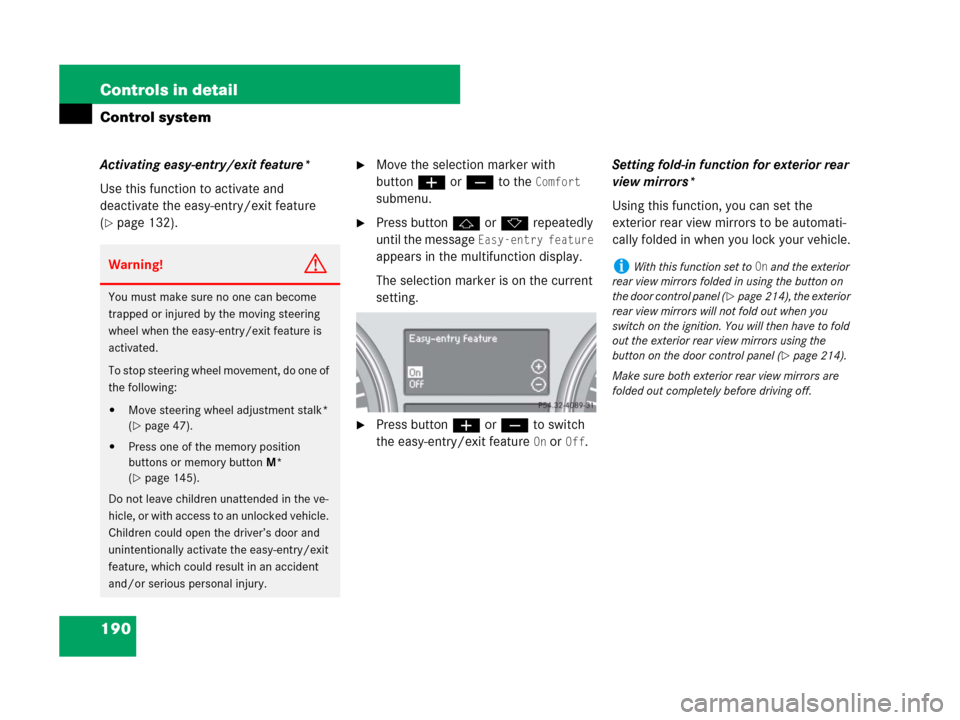
190 Controls in detail
Control system
Activating easy-entry/exit feature*
Use this function to activate and
deactivate the easy-entry/exit feature
(
�page 132).
�Move the selection marker with
buttonæ orç to the
Comfort
submenu.
�Press buttonj ork repeatedly
until the message
Easy-entry feature
appears in the multifunction display.
The selection marker is on the current
setting.
�Press buttonæ orç to switch
the easy-entry/exit feature
On or Off.Setting fold-in function for exterior rear
view mirrors*
Using this function, you can set the
exterior rear view mirrors to be automati-
cally folded in when you lock your vehicle.
Warning!G
You must make sure no one can become
trapped or injured by the moving steering
wheel when the easy-entry/exit feature is
activated.
To stop steering wheel movement, do one of
the following:
�Move steering wheel adjustment stalk*
(
�page 47).
�Press one of the memory position
buttons or memory button M*
(
�page 145).
Do not leave children unattended in the ve-
hicle, or with access to an unlocked vehicle.
Children could open the driver’s door and
unintentionally activate the easy-entry/exit
feature, which could result in an accident
and/or serious personal injury.
iWith this function set to On and the exterior
rear view mirrors folded in using the button on
the door control panel (
�page 214), the exterior
rear view mirrors will not fold out when you
switch on the ignition. You will then have to fold
out the exterior rear view mirrors using the
button on the door control panel (
�page 214).
Make sure both exterior rear view mirrors are
folded out completely before driving off.
Page 213 of 570
212 Controls in detail
Good visibility
For information on the windshield wipers,
see “Windshield wipers” (
�page 60).
Headlamp cleaning system*
The button is located on the left side of the
dashboard.
1Headlamp washer button
�Switch on the ignition (�page 39).
�Press button1.
The headlamps are cleaned with a
high-pressure water jet.
For information on filling up the washer
reservoir, see “Windshield/rear window
washer system and headlamp cleaning*
system” (
�page 372).
Rear view mirrors
For more information on setting the rear
view mirrors, see “Mirrors” (
�page 48).
Interior rear view mirror, antiglare
position
1Lever
�Tilt the mirror to the antiglare position
by moving lever1 towards the wind-
shield.
The interior rear view mirror is dimmed.
iThe headlamps will automatically be
cleaned when you have
�switched on the headlamps
and
�operated the windshield wipers with wind-
shield washer fluid fifteen times
When you switch off the ignition, the counter
resets.
Page 214 of 570
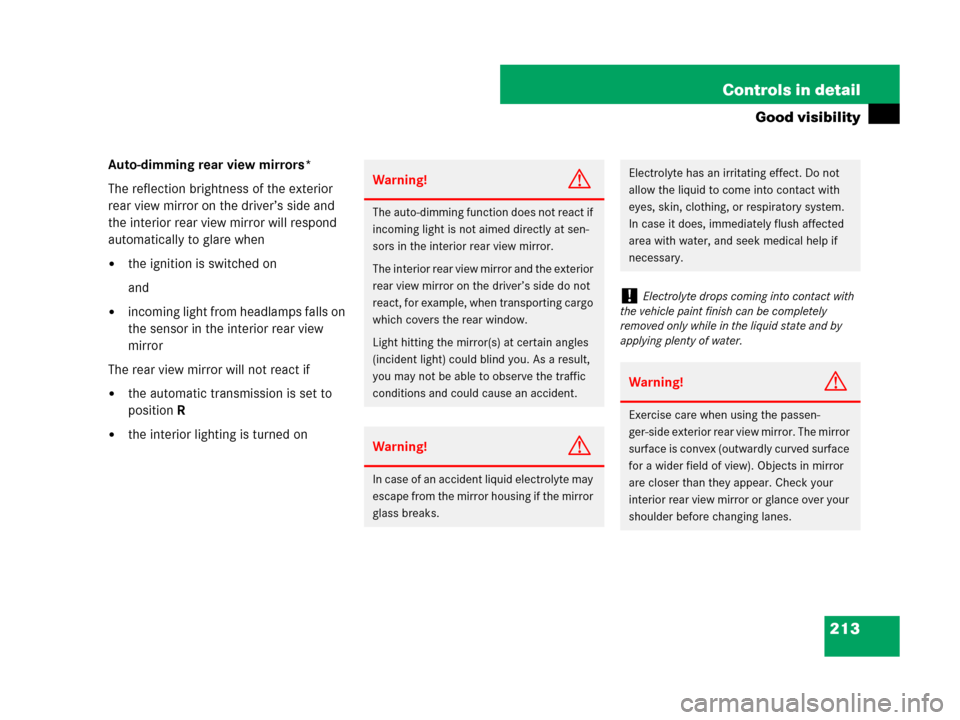
213 Controls in detail
Good visibility
Auto-dimming rear view mirrors*
The reflection brightness of the exterior
rear view mirror on the driver’s side and
the interior rear view mirror will respond
automatically to glare when
�the ignition is switched on
and
�incoming light from headlamps falls on
the sensor in the interior rear view
mirror
The rear view mirror will not react if
�the automatic transmission is set to
positionR
�the interior lighting is turned on
Warning!G
The auto-dimming function does not react if
incoming light is not aimed directly at sen-
sors in the interior rear view mirror.
The interior rear view mirror and the exterior
rear view mirror on the driver’s side do not
react, for example, when transporting cargo
which covers the rear window.
Light hitting the mirror(s) at certain angles
(incident light) could blind you. As a result,
you may not be able to observe the traffic
conditions and could cause an accident.
Warning!G
In case of an accident liquid electrolyte may
escape from the mirror housing if the mirror
glass breaks.
Electrolyte has an irritating effect. Do not
allow the liquid to come into contact with
eyes, skin, clothing, or respiratory system.
In case it does, immediately flush affected
area with water, and seek medical help if
necessary.
!Electrolyte drops coming into contact with
the vehicle paint finish can be completely
removed only while in the liquid state and by
applying plenty of water.
Warning!G
Exercise care when using the passen-
ger-side exterior rear view mirror. The mirror
surface is convex (outwardly curved surface
for a wider field of view). Objects in mirror
are closer than they appear. Check your
interior rear view mirror or glance over your
shoulder before changing lanes.
Page 215 of 570
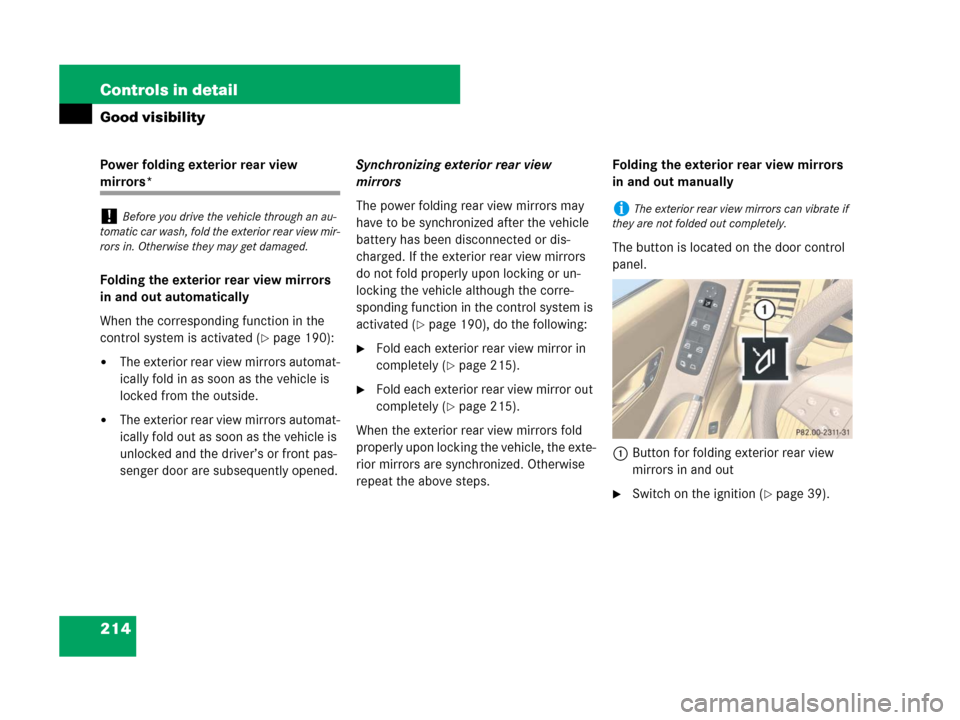
214 Controls in detail
Good visibility
Power folding exterior rear view
mirrors*
Folding the exterior rear view mirrors
in and out automatically
When the corresponding function in the
control system is activated (
�page 190):
�The exterior rear view mirrors automat-
ically fold in as soon as the vehicle is
locked from the outside.
�The exterior rear view mirrors automat-
ically fold out as soon as the vehicle is
unlocked and the driver’s or front pas-
senger door are subsequently opened.Synchronizing exterior rear view
mirrors
The power folding rear view mirrors may
have to be synchronized after the vehicle
battery has been disconnected or dis-
charged. If the exterior rear view mirrors
do not fold properly upon locking or un-
locking the vehicle although the corre-
sponding function in the control system is
activated (
�page 190), do the following:
�Fold each exterior rear view mirror in
completely (
�page 215).
�Fold each exterior rear view mirror out
completely (
�page 215).
When the exterior rear view mirrors fold
properly upon locking the vehicle, the exte-
rior mirrors are synchronized. Otherwise
repeat the above steps.Folding the exterior rear view mirrors
in and out manually
The button is located on the door control
panel.
1Button for folding exterior rear view
mirrors in and out
�Switch on the ignition (�page 39).
!Before you drive the vehicle through an au-
tomatic car wash, fold the exterior rear view mir-
rors in. Otherwise they may get damaged.iThe exterior rear view mirrors can vibrate if
they are not folded out completely.
Page 218 of 570
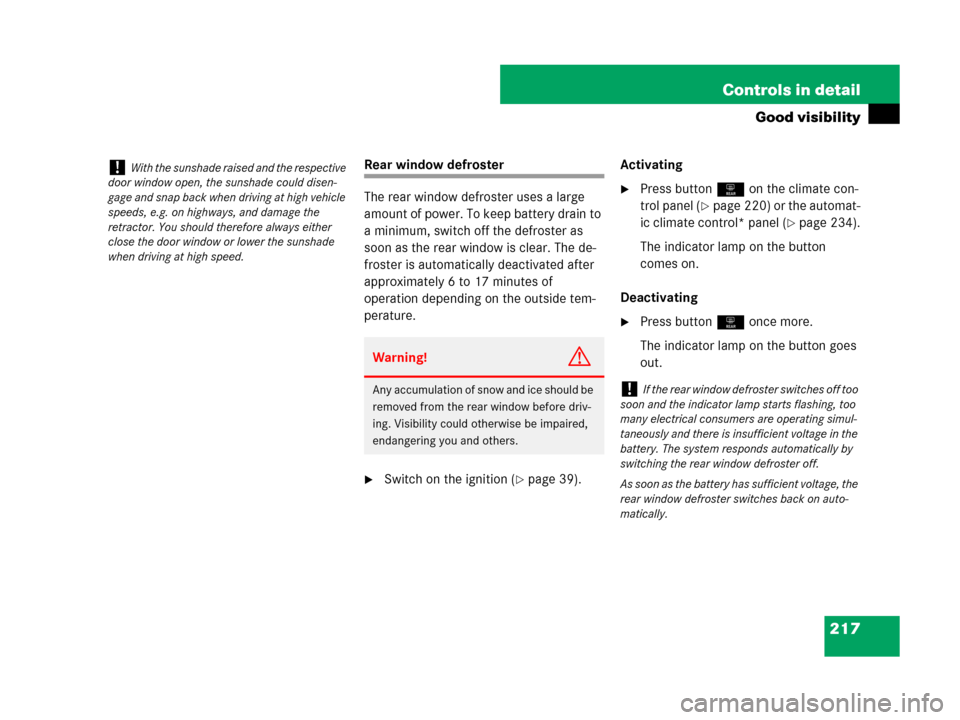
217 Controls in detail
Good visibility
Rear window defroster
The rear window defroster uses a large
amount of power. To keep battery drain to
a minimum, switch off the defroster as
soon as the rear window is clear. The de-
froster is automatically deactivated after
approximately 6 to 17 minutes of
operation depending on the outside tem-
perature.
�Switch on the ignition (�page 39).Activating
�Press button1 on the climate con-
trol panel (
�page 220) or the automat-
ic climate control* panel (
�page 234).
The indicator lamp on the button
comes on.
Deactivating
�Press button1 once more.
The indicator lamp on the button goes
out.
!With the sunshade raised and the respective
door window open, the sunshade could disen-
gage and snap back when driving at high vehicle
speeds, e.g. on highways, and damage the
retractor. You should therefore always either
close the door window or lower the sunshade
when driving at high speed.
Warning!G
Any accumulation of snow and ice should be
removed from the rear window before driv-
ing. Visibility could otherwise be impaired,
endangering you and others.!If the rear window defroster switches off too
soon and the indicator lamp starts flashing, too
many electrical consumers are operating simul-
taneously and there is insufficient voltage in the
battery. The system responds automatically by
switching the rear window defroster off.
As soon as the battery has sufficient voltage, the
rear window defroster switches back on auto-
matically.
Page 230 of 570
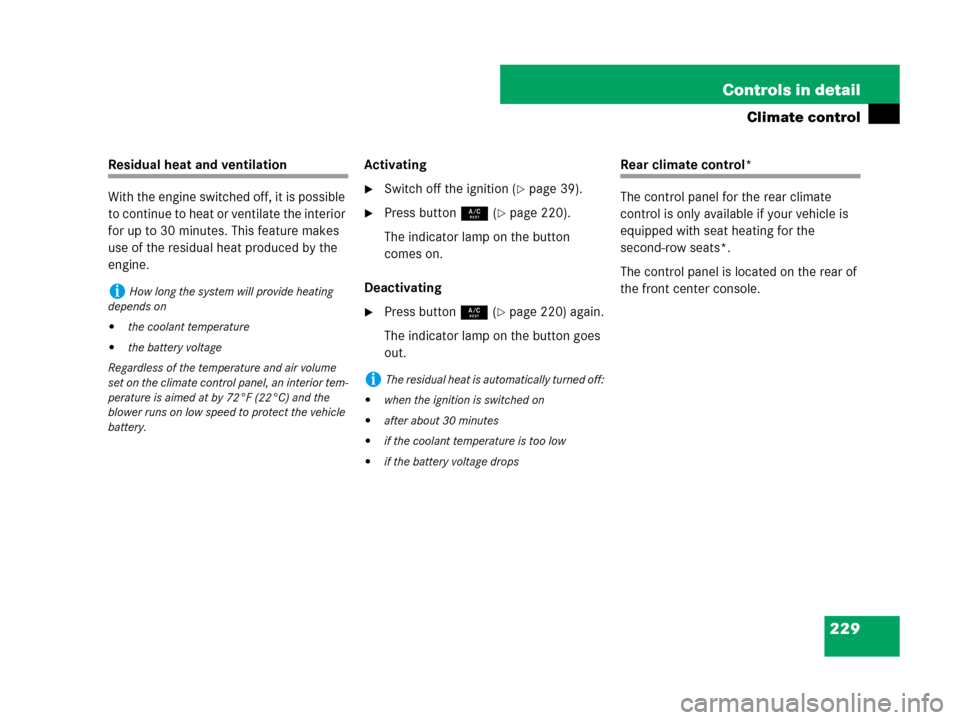
229 Controls in detail
Climate control
Residual heat and ventilation
With the engine switched off, it is possible
to continue to heat or ventilate the interior
for up to 30 minutes. This feature makes
use of the residual heat produced by the
engine.Activating
�Switch off the ignition (�page 39).
�Press button9 (�page 220).
The indicator lamp on the button
comes on.
Deactivating
�Press button9 (�page 220) again.
The indicator lamp on the button goes
out.
Rear climate control*
The control panel for the rear climate
control is only available if your vehicle is
equipped with seat heating for the
second-row seats*.
The control panel is located on the rear of
the front center console.
iHow long the system will provide heating
depends on
�the coolant temperature
�the battery voltage
Regardless of the temperature and air volume
set on the climate control panel, an interior tem-
perature is aimed at by 72°F (22°C) and the
blower runs on low speed to protect the vehicle
battery.
iThe residual heat is automatically turned off:
�when the ignition is switched on
�after about 30 minutes
�if the coolant temperature is too low
�if the battery voltage drops
Page 246 of 570
245 Controls in detail
3-zone automatic climate control*
Activating
�Switch off the ignition (�page 39).
�Press button9 (�page 234).
The indicator lamp on the button
comes on.
Deactivating
�Press button9.
The indicator lamp on the button goes
out.Rear automatic climate control
(second row)
The control panel is located at the rear of
the front center console.
Rear automatic climate control panel
iThe residual heat is automatically turned off:
�when the ignition is switched on
�after about 30 minutes
�if the coolant temperature is too low
�if the battery voltage drops
1Increasing air volume
2Air distribution and air volume
(automatic, manual)
3Air distribution (directs air through
the side air vents
4Right rear center air vent, adjustable
5Air distribution (directs air through
the footwells and side air vents)
6Rear automatic climate control
on/off
7Decreasing air volume
8Left rear center air vent, adjustable
9Indicator lamps for air volume
settings
aTemperature control
Page 252 of 570
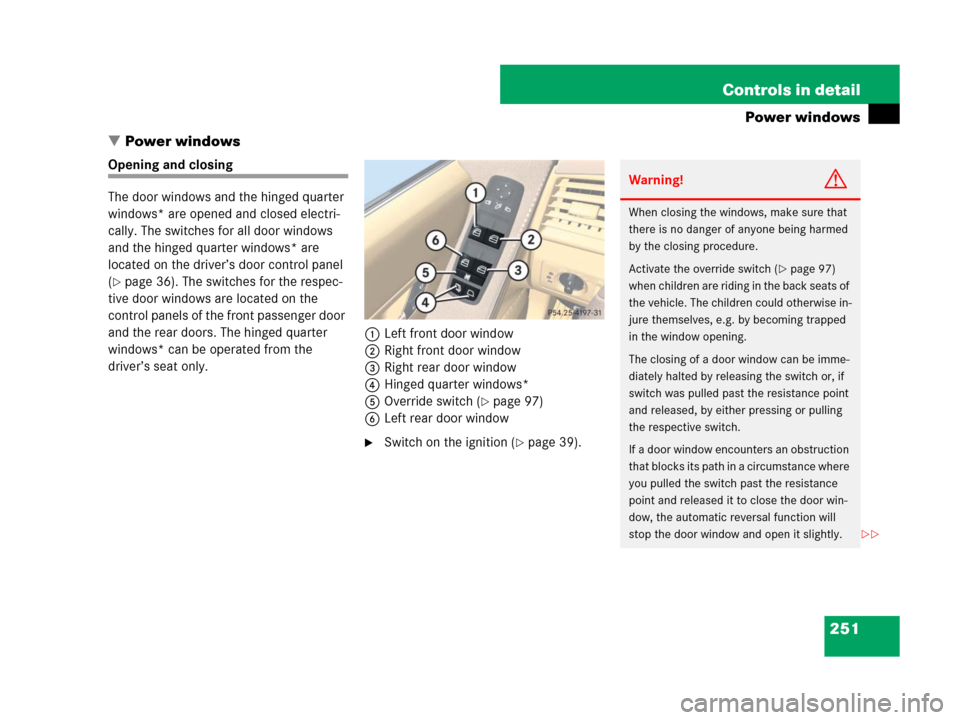
251 Controls in detail
Power windows
�Power windows
Opening and closing
The door windows and the hinged quarter
windows* are opened and closed electri-
cally. The switches for all door windows
and the hinged quarter windows* are
located on the driver’s door control panel
(
�page 36). The switches for the respec-
tive door windows are located on the
control panels of the front passenger door
and the rear doors. The hinged quarter
windows* can be operated from the
driver’s seat only.1Left front door window
2Right front door window
3Right rear door window
4Hinged quarter windows*
5Override switch (
�page 97)
6Left rear door window
�Switch on the ignition (�page 39).
Warning!G
When closing the windows, make sure that
there is no danger of anyone being harmed
by the closing procedure.
Activate the override switch (
�page 97)
when children are riding in the back seats of
the vehicle. The children could otherwise in-
jure themselves, e.g. by becoming trapped
in the window opening.
The closing of a door window can be imme-
diately halted by releasing the switch or, if
switch was pulled past the resistance point
and released, by either pressing or pulling
the respective switch.
If a door window encounters an obstruction
that blocks its path in a circumstance where
you pulled the switch past the resistance
point and released it to close the door win-
dow, the automatic reversal function will
stop the door window and open it slightly.
��